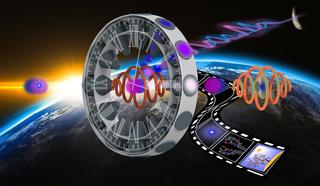Attosecond project receives around 1.4 million Euros in funding from the BMBF
A consortium of researchers from the University of Hamburg and DESY (at CFEL) together with the European XFEL and the Technical University of Dortmund have received around 1.4 million Euros funding from the Federal Ministry for Education and Research (BMBF). The research project “AttoSee” will focus on bringing attosecond time resolution to a combination of UV and X-ray pulses - and thus originate a whole new perspective on the dynamics of Nature and Life.
The AttoSee project will use a technique called angular streaking to reveal the temporal structure of and synchronization between ultrashort UV pulses in combination with the observational vantage point offered by X-rays in a new atto-clock instrument for FEL science. This opens the door to filming the quantum cosmos at work on the most extreme timescales with direct implications for the structure of life and it's fastest processes.
Illustration: M. Ilchen with material from [ https://doi.org/10.1103/PhysRevResearch.7.011001 and https://doi.org/10.48550/arXiv.2408.03858] and pixabay.com
Studying Nature at the inherent time scale of electron dynamics enables access to some of the fastest processes in matter, captured at the very instant they begin. Electrons shape our existence to an unfathomable extent. Beyond driving a variety of fundamental physical phenomena, their interactions in atoms and molecules form the very foundation of chemistry.
Recently, a series of breakthroughs at the European XFEL has opened novel avenues for investigating electronic processes in matter. Thanks to intense attosecond pulses of tunable high-energy X-ray photons, scientists are now able to site-specifically choose the vantage point to best observe fleeting quantum processes in action. At the same time, physical processes triggered by visible and ultraviolet photons are vitally important for humans and life on earth. Studying processes induced by ultrashort UV pulses in combination with the observational vantage point offered by X-rays, requires a measurement of the time between the UV and X-ray pulses, accurate to the attosecond level. The AttoSee project aims to achieve this using a technique called angular streaking, making it the very first timing tool in the world with this capability.
“The ability to combine the two energy scales offers unique opportunities for studying the photophysics of important chemical and biological samples”, says Markus Ilchen, Professor of Physics at the University of Hamburg and a researcher at the Cluster of Excellence “CUI: Advanced Imaging of Matter”. He organizes the project together with Dr. Terry Mullins and Prof. Francesca Calegari from the Attosecond Science group at DESY, Dr. Michael Meyer from the European XFEL, and Jun.-Prof. Dr. Wolfram Helml from the Technische Universität Dortmund.
“This pivotal advancement in timing precision will allow the future investigation of matter in a regime that was previously out of reach.” says Prof. Calegari, one of the Cluster’s spokespersons.
“Although laser-based attosecond physics has already been recognized with a Nobel Prize, we find ourselves in the very infancy of this fascinating field of science, particularly with X-rays. Tremendous opportunities and challenges lie ahead of us,” Mullins emphasizes. New instrumentation, new methodology, and new fundamental insights into attosecond processes will be required to tackle the challenging tasks ahead of the scientists. Merging forces of world-leading groups from optical laser and X-ray science with ultrashort pulses, “AttoSee” is set to break ground for the investigation of UV triggered processes on the attosecond timescale with full element specificity.
The AttoSee project will use a technique called angular streaking to reveal the temporal structure of and synchronization between ultrashort UV pulses in combination with the observational vantage point offered by X-rays in a new atto-clock instrument for FEL science. This opens the door to filming the quantum cosmos at work on the most extreme timescales with direct implications for the structure of life and its fastest processes.
